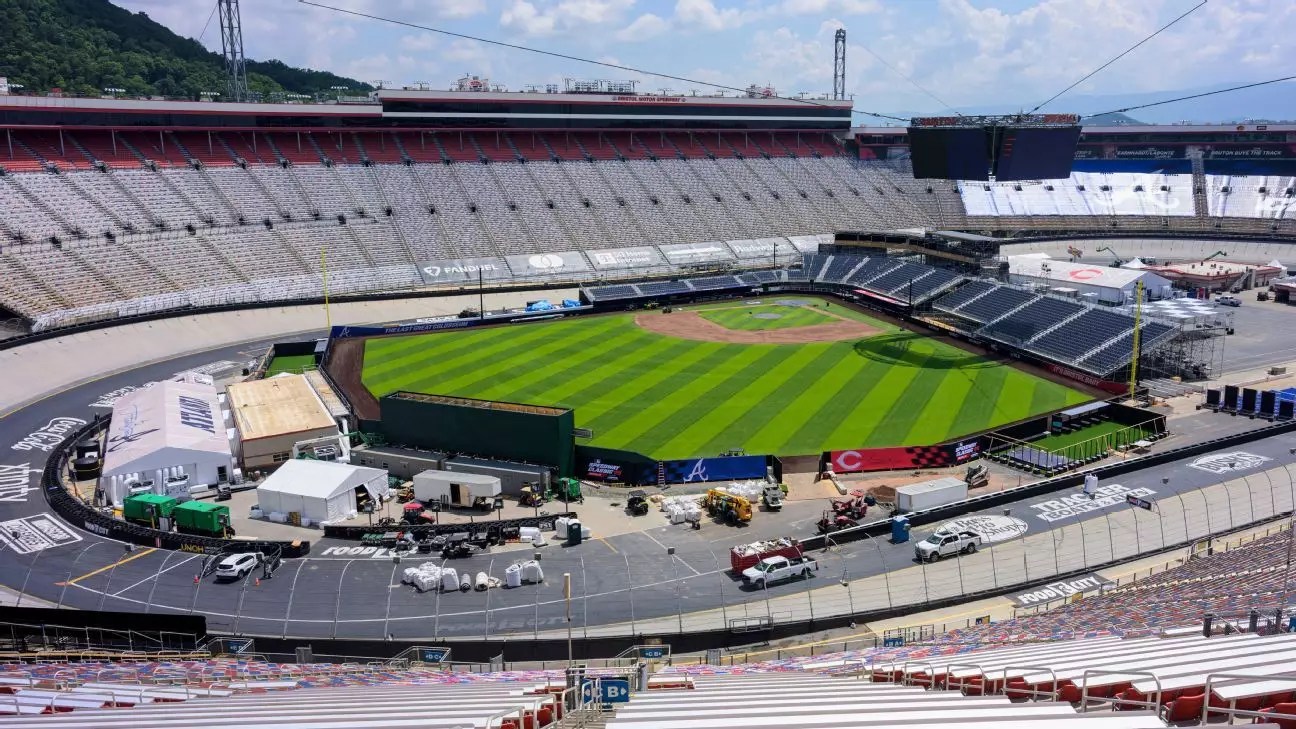Bristol Motor Speedway, long celebrated as a powerhouse of motorsport and outdoor entertainment, finds itself at a fascinating crossroads. The facility, renowned for its iconic racetrack, recently etched its name into sports history by hosting Tennessee’s first MLB game, a spectacle that drew over 91,000 spectators. This event not only showcased the versatility of Bristol but also challenged the longstanding expectations surrounding the venue. Now, with the echo of baseball cheers fading, the focus shifts swiftly back to NASCAR’s roar, demanding a rapid yet meticulous transformation.
The speed and precision with which the Bristol team orchestrated the transition from a baseball field back to a racing surface reveals a robust capacity for adaptability. Constructing baseball infields with intricate facilities—complete with clubhouses, batting cages, and broadcast booths—was a colossal undertaking that required temporary sacrifices of the traditional racing infrastructure. Removal of pit walls and the rapid reinstallation of asphalt and concrete demonstrate a vehicle for flexibility that might redefine what is possible in sports venue management.
Challenges of Rapid Conversion: A Close Look at Logistics and Infrastructure
Transforming Bristol’s infield back into a racing surface involves more than just shifting dirt and re-laying asphalt. The logistical complexity is staggering. Hundreds of tons of gravel and clay had to be placed with extraordinary precision to ensure the surface meets NASCAR standards, all under a tight schedule. The team’s ability to source, transport, and lay down these materials—while simultaneously disassembling baseball-specific structures—speaks to a level of operational mastery that borders on artistry.
But it’s more than just materials and construction. Underpinning this transformation is the challenge of timing. The entire process hinges on a delicate balance between speed and quality assurance. Swift, the senior vice president of operations, emphasizes the importance of curing times for concrete and the careful consideration given to preserving the integrity of both sports. Every decision is a calculated risk, with the deadline set for September 7—a mere days before the NASCAR race.
This tight schedule also invites reflection on the sustainability of such rapid turnarounds. Reusing gravel for parking lots and repurposing wood and plywood from the grandstands highlights an environmentally conscious mentality. It transforms what could be considered waste into valuable resources, amplifying the message that stadiums and raceways can be eco-friendly and multifunctional.
Breaking the Boundaries of Venue Utility: From Traditional Expectations to Future Possibilities
Bristol’s ability to host college football, baseball, and potentially an NHL event signals a broader trend—venue versatility as a competitive edge. The success of these varied events underscores an important point: stadiums and race tracks are no longer just single-purpose arenas. Instead, they are dynamic stagesets capable of hosting diverse sports and entertainment formats, making them invaluable community assets.
Such flexibility can redefine the economic and cultural impact of sports venues. When a racetrack can pivot seamlessly into a baseball diamond or a football field—and then return—its value multiplies exponentially. It becomes a hub of activity, capable of attracting different audiences and generating revenue through multiple channels.
Moreover, Bristol’s proactive approach — preparing for the next event even amid ongoing transformations — demonstrates a strategic vision rooted in innovation. It positions the venue as a pioneer, eager to embrace new challenges and redefine its role in American sports and entertainment landscapes. This approach not only enhances its reputation but also sets a precedent for other venues to follow.
The Enduring Spirit of Innovation and Resilience
Bristol’s audacious experiment embodies an inspiring blend of resilience, creativity, and strategic foresight. Faced with the daunting task of transforming the field within a matter of days, the team’s collective effort underscores a cultural attitude that refuses to see limits—only opportunities. Their success in flawlessly reverting the space back to a NASCAR-ready track, despite initial complexities, signals a future where versatility becomes the standard.
The significance of this evolution extends beyond mere logistics. It challenges traditional notions of what sports venues can be, fostering a mindset of adaptability that aligns with the increasingly diverse interests of modern sports fans. If Bristol can handle such radical transformations, other venues might soon follow suit, opening new doors for innovation in stadium design and event hosting.
The boldness displayed here is not just about technical mastery; it’s about envisioning a future where the boundaries of sports and entertainment blur, creating shared spaces that thrive on flexibility and ingenuity. Bristol’s journey from baseball to racing—and possibly beyond—serves as a testament to what can be achieved when audacity meets meticulous planning. It’s a story not just of physical transformation, but of the relentless pursuit of pioneering new paradigms in sports and community engagement.


Leave a Reply